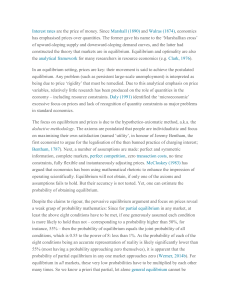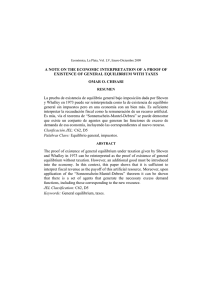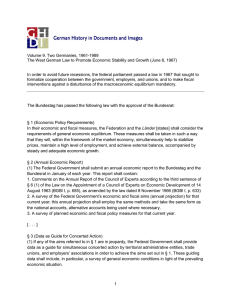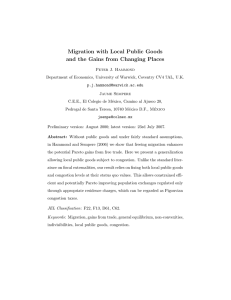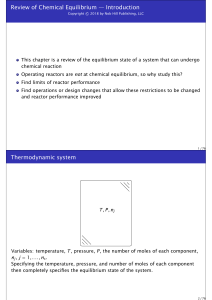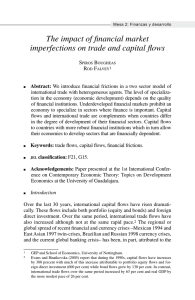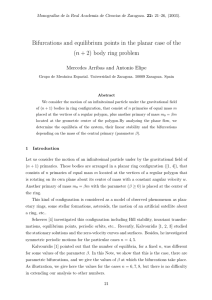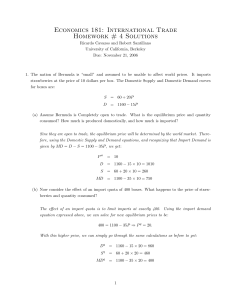Existence of Walrasian Equilibrium
Anuncio
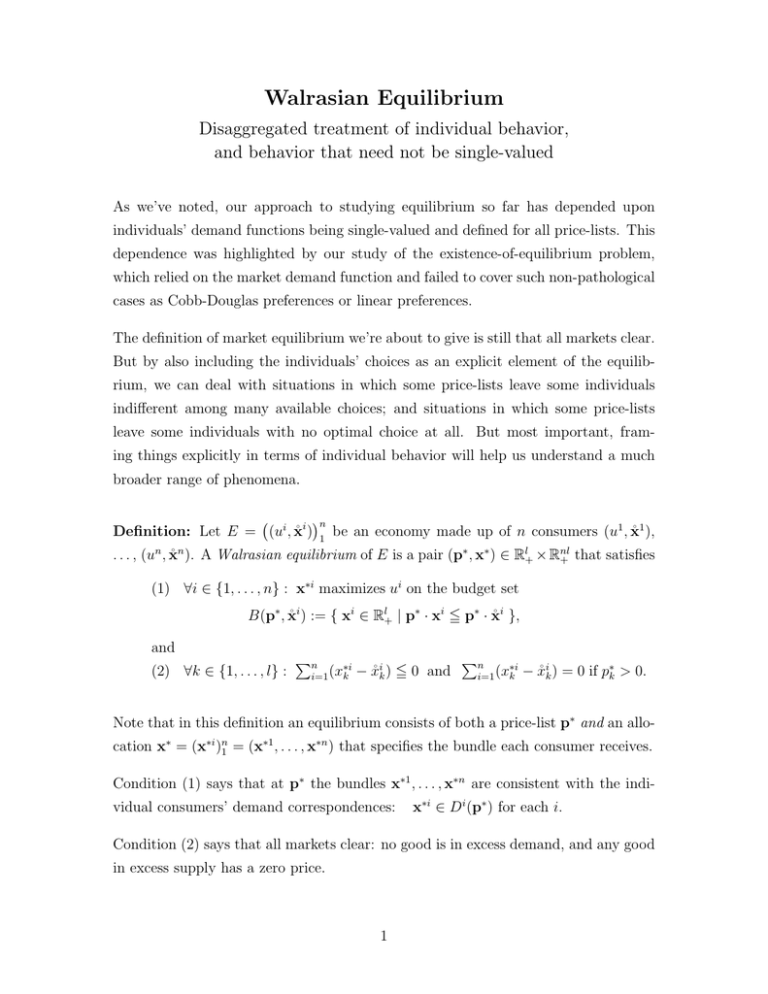
Walrasian Equilibrium
Disaggregated treatment of individual behavior,
and behavior that need not be single-valued
As we’ve noted, our approach to studying equilibrium so far has depended upon
individuals’ demand functions being single-valued and defined for all price-lists. This
dependence was highlighted by our study of the existence-of-equilibrium problem,
which relied on the market demand function and failed to cover such non-pathological
cases as Cobb-Douglas preferences or linear preferences.
The definition of market equilibrium we’re about to give is still that all markets clear.
But by also including the individuals’ choices as an explicit element of the equilibrium, we can deal with situations in which some price-lists leave some individuals
indifferent among many available choices; and situations in which some price-lists
leave some individuals with no optimal choice at all. But most important, framing things explicitly in terms of individual behavior will help us understand a much
broader range of phenomena.
n
Definition: Let E = (ui ,x̊i ) 1 be an economy made up of n consumers (u1 ,x̊1 ),
. . . , (un ,x̊n ). A Walrasian equilibrium of E is a pair (p∗ , x∗ ) ∈ Rl+ × Rnl
+ that satisfies
(1) ∀i ∈ {1, . . . , n} : x∗i maximizes ui on the budget set
B(p∗ ,x̊i ) := { xi ∈ Rl+ | p∗ · xi 5 p∗ · x̊i },
and
(2) ∀k ∈ {1, . . . , l} :
Pn
∗i
i=1 (xk
− x̊ik ) 5 0 and
Pn
∗i
i=1 (xk
− x̊ik ) = 0 if p∗k > 0.
Note that in this definition an equilibrium consists of both a price-list p∗ and an allocation x∗ = (x∗i )n1 = (x∗1 , . . . , x∗n ) that specifies the bundle each consumer receives.
Condition (1) says that at p∗ the bundles x∗1 , . . . , x∗n are consistent with the individual consumers’ demand correspondences:
x∗i ∈ Di (p∗ ) for each i.
Condition (2) says that all markets clear: no good is in excess demand, and any good
in excess supply has a zero price.
1
Existence of Walrasian Equilibrium
This theorem allows for undefined demands (as would happen, for example, if a price
were zero and some utility function were strictly increasing) and for weak convexity
of preferences.
n
Theorem: Let E = ((ui ,x̊i ))1 be an exchange economy. If each consumer (ui ,x̊i )
satisfies the conditions
(a) ui is continuous, increasing, and quasi-concave, and
(b) x̊ik > 0,
k = 1, . . . , l,
then E has a Walrasian equilibrium.
Proof:
For each i, let Di : S →→ Rl+ and ζ i : S →→ Rl be consumer i’s demand and net
demand correspondences, restricted to the simplex S in Rl :
Di (p) := {xi ∈ Rl+ | xi maximizes ui on B(p,x̊i }, and
ζ i (p) := Di (p) − x̊i .
We define a “truncated version” of the economy E, in which the consumers’ chosen
bundles are constrained to lie within a given compact set K. To begin with, let
P
β := 1 + max{x̊k | k = 1, . . . , l}, where x̊ = ni=1 x̊i , and let K denote the cube
K := {x ∈ Rl+ | |xk | 5 β, k = 1, . . . , l}.
b i : S →→ Rl+ , and ζbi : S →→ Rl by
For each i, define ϕi : S →→ Rl+ , D
ϕi (p) := B(p,x̊i ) ∩ K,
b i (p) := {xi ∈ Rl+ | xi maximizes ui on ϕi (p)} , and
D
b i (p) − x̊i .
ζbi (p) := D
b i (·) is his truncated demand
Note that ϕi (p) is the consumer’s truncated budget set, D
correspondence, and ζbi (·) is his truncated net demand correspondence. The set K is
compact, each ui is continuous, and each ϕi is a continuous correspondence; therefore
b i has a closed graph. Therefore each ζbi
the Maximum Theorem guarantees that each D
has a closed graph as well, and consequently the truncated economy’s excess demand
b := Pn ζbi (·) also has a closed graph.
correspondence ζ(·)
1
2
We will first show that ζb has a “market level” (Arrow & Hahn-type) equilibrium –
i.e., that
(1) there is a p∗ ∈ S and a z∗ ∈ Rl for which z∗ ∈ ζbi (p∗ ) and z∗ 5 0 and p∗k > 0 ⇒
zk∗ = 0.
Then we will
(2) find an allocation (x∗i )n1 that is consistent with the market net demand z∗ .
Finally we will show that
(3) (p∗ , (x∗i )n1 ) is a Walrasian equilibrium for E.
We use a fixed-point argument to establish (1). Note that because K is compact and
each ui is continuous, each ζbi must be non-empty-valued on S and therefore ζb is also
non-empty-valued on S. If ζb is also single-valued, we can simply apply our existence
result from Arrow & Hahn. More generally (since ζb may be multi-valued), we define
a “price adjustment” correspondence µ : K →→ S as follows:
µ(z) := {p ∈ S | p maximizes p · z on S}
and a “transition” correspondence f : S × K →→ S × K by
b
f (p, z) := µ(z) × ζ(p).
Note that in this construction we take the state space to be S × K, not just S, so
that a state is both a price-list and a net demand bundle; and that just as in our
previous existence proof, the transition function/correspondence f is “made up” – it
does not represent the actual dynamic path of prices and quantities. As in the Arrow
& Hahn proof, we will show that f has a fixed point (p∗ , z∗ ) and then show that any
such (p∗ , z∗ ) must satisfy (1).
We know that ζb has a closed graph and is non-empty-valued and convex-valued, and
it is easy to show that µ has the same properties. Therefore so does f , and Kakutani’s
Theorem therefore implies that f has a fixed point.
Let (p∗ , z∗ ) be a fixed point of f . Because p∗ ∈ µ(z∗ ), we have p·z∗ 5 p∗ ·z∗ for every
b ∗ ), and because ζb satisfies Walras’s
p ∈ S. We also have p∗ · z∗ = 0, because z∗ ∈ ζ(p
3
Law (each ui is strictly increasing). Combining p · z∗ 5 p∗ · z∗ (for all p ∈ S) and
p∗ · z∗ = 0 yields p · z∗ 5 0 for every p ∈ S, from which it follows that z∗ 5 0 – i.e.,
that zk∗ 5 0 for each k. (Suppose, for example, that z1∗ > 0. Then (1, 0, . . . , 0) · z∗ > 0.
But we have shown that p · z∗ 5 0 for every p ∈ S.) The final part of (1) follows
from our familiar argument: since each p∗k = 0 and each zk∗ 5 0, and p∗ · z∗ = 0, we
have p∗k > 0 ⇒ zk∗ = 0.
b ∗) =
In order to accomplish step (2), we use the z∗ from (1), as follows: Since z∗ ∈ ζ(p
Pn bi ∗
∗1
∗n
such that z∗i ∈ ζbi (p∗ ) for each i and such
1 ζ (p ), there are bundles z , . . . , z
P
b i (p) − x̊i . Thus, for any z∗i ∈ ζbi (p∗ ), there is an
that n z∗i = z∗ . But ζbi (p∗ ) = D
1
∗i
x
b i (p∗ ) such that z∗i = x∗i − x̊i – namely x∗i = x̊i + z∗i . This gives us the
∈ D
allocation (x∗i )n1 in (2).
We now establish (3) – that (p∗ , (x∗i )n1 ) is a Walrasian equilibrium for E. The marketP
P
P
clearing equilibrium condition, n1 x∗i 5 n1 x̊i , is straightforward: z∗ = n1 z∗i =
Pn ∗i
i
∗
1 (x −x̊ ), from (2), and z 5 0, from (1). It remains only to establish the utilityb i (p∗ ) –
maximizing equilibrium condition, that each x∗i is in Di (p∗ ), not merely in D
in other words, that at p∗ the truncation of each consumer’s budget set to the cube
K is not actually binding, i.e., that at p∗ the consumer would choose x∗i even if all
b i (p∗ ) for each i, from (2). Moreover, we
of B(p∗ ,x̊i } were available. We have x∗i ∈ D
P
P
n ∗j
n j
∗i
also have x∗i
k 5
1 xk 5
1 x̊k < β for each k; therefore each x is in the interior
of K. Now suppose that x∗i 6∈ Di (p∗ ) for some i – i.e., there is an x̃i ∈ R such that
p∗ · x̃i 5 p∗ · x̊i and ui (x̃i ) > ui (x∗i ). Since the budget set B(p∗ ,x̊i } is convex, every
bundle on the line segment [x̃i , x∗i ] is also in B(p∗ ,x̊i }; and since ui (x̃i ) > ui (x∗i ) and
ui is quasi-concave, every bundle xi on this line segment also satisfies ui (xi ) > ui (x∗i ).
Further, every neighborhood of x∗i contains bundles on this line segment; and since
x∗i ∈ intK, there are bundles xi ∈ B(p∗ ,x̊i } ∩ K that lie on the line segment and
b i (p∗ ), contrary to
which therefore satisfy ui (xi ) > ui (x∗i ). Consequently, x∗i 6∈ D
what we have already shown, and therefore we must have x∗i ∈ Di (p∗ ) after all. k
Figure 1 depicts the argument in the final paragraph of the proof. Figure 2 shows
why the argument requires that x∗i ∈ intK.
4
Figure 1: The argument showing that x∗i ∈ Di (p∗ )
5
Figure 2: The argument doesn’t work if x∗i 6∈ intK
6
